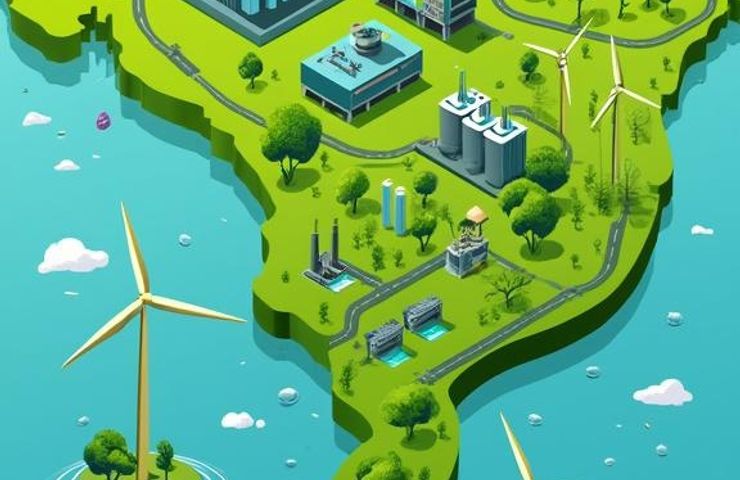
Green hydrogen: Rio Grande do Sul’s R$102.4 Million Game-Changer for Clean Energy
August 12, 2025Down at the southern tip of Brazil, where about 11.3 million people live, Rio Grande do Sul is quietly staking its claim as a national frontrunner in green hydrogen. On August 12, 2025, the regional government turned heads by picking twelve companies to move forward into the third phase of its Hydrogen program—formally known as the Green Hydrogen Production Chain Development Programme. Fueled by a R$102.4 million pot, this tender is all about cutting emissions in heavy industry, boosting a homegrown supply chain, and setting the stage for the state to become a global exporter of clean molecules.
This push didn’t appear out of thin air. It builds on a broader renewable energy strategy that kicked off in 2023, targeting refineries, industrial heat, and heavy road transport. With wind farms and solar parks already feeding power to the grid, Rio Grande do Sul is the perfect living lab for rolling out electrolyzers on a big scale.
A Bold Tender for Green Hydrogen
Earlier this year, the Secretariat of Environment and Infrastructure (Sema) teamed up with Badesul Development Bank to launch a R$102.4 million public call aimed at turbocharging green hydrogen production. Each project can apply for up to R$30 million, provided they put up at least 30 percent co-investment—making sure everyone has real skin in the game. It’s one of the largest state-level hydrogen tenders in Brazil, covering everything from production and storage to transmission and end-use.
Submissions have run the gamut: standalone electrolysis plants, integrated hydrogen-to-ammonia facilities, industrial co-generation units, and heavy-transport fueling stations. By aligning public incentives with private capital, the state is sending a clear message: decarbonization through green hydrogen is no longer optional.
Leading the Charge: Pre-Approved and Shortlisted Projects
Before this third stage even kicked off, four flagship initiatives had already nabbed preliminary approval. They include manufacturing powerhouse Tramontina, the Refinaria Riograndense oil refinery eyeing on-site emissions cuts, agrotech specialist Begreen Bioenergia e Fertilizantes Sustentáveis S.A., and energy solutions provider Âmbar Sul Energia S.A.. Together, they’re piloting projects in industrial heating, ammonia synthesis, and on-site hydrogen use.
Now, they’re joined by eight fresh contenders: BE8 S.A., Leal Consultoria e Inovações, Sandero Indústria e Comércio de Produtos Químicos, RenoBrax Campanha Energia Renováveis, Infravix Engenharia, Verdhe Engenharia do Hidrogênio, Rodoplast Indústria Comércio de Componentes Plásticos, and RD Locações. This lineup spans biofuels, chemical manufacturing, engineering design, equipment leasing—each piece key to knitting together a robust hydrogen ecosystem.
A Deep Dive into Green Hydrogen and Ammonia
At the heart of this whole effort is green hydrogen. You make it by splitting water into hydrogen and oxygen through electrolysis powered entirely by renewables—so there’s zero CO₂ output. Electrolyzers, whether they’re alkaline units or PEM systems, can range from compact kilowatt modules to sprawling multi-megawatt plants.
But the story doesn’t stop at hydrogen. The roadmap also includes green ammonia, churned out via the Haber-Bosch process using renewable hydrogen and nitrogen pulled from the air. Green ammonia doubles as a carbon-free fertilizer and a handy energy carrier, ready for export. Case in point: back in 2023, Rio Grande do Sul struck a MoU with Italy’s EN.IT SpA to ship up to 250,000 tonnes a year.
Rigorous Evaluation and Next Steps
What’s next for those twelve hopefuls? They’ll undergo a deep-dive review by a Specialized Technical Committee, alongside Badesul’s number-crunchers. These reviewers will pore over engineering drawings, budget breakdowns, and risk mitigation plans. Only the projects that prove technically solid, commercially viable, and on a clear timeline will nab the final funding green light and march into construction.
All the details—think project specs, timelines, and budgets—will land on the state’s ProClima 2050 portal, ensuring full transparency and opening the door for broader collaboration. We’re on the verge of seeing groundbreaking facilities pop up across Rio Grande do Sul.
Building a Local Green Hydrogen Ecosystem
This tender is just the latest move in a game plan that’s been in play since 2023. Since then, the state has closed MoUs to develop three green hydrogen and ammonia plants with Begreen and forged international ties through EN.IT. Those early partnerships are laying the groundwork for a homegrown supply chain, spanning electrolyzer manufacturing, balance-of-plant services, logistics, and port operations.
As pilot projects graduate to full-scale deployment, we’re looking at thousands of direct and indirect job openings. Civil engineers, plant operators, chemists, logistics coordinators, safety experts—you name it. It’s a one-two punch for economic development and decarbonization.
Economic and Environmental Impacts
By sparking a dozen-plus large-scale green hydrogen projects, Rio Grande do Sul expects to avoid tens of thousands of tonnes of CO₂ each year. The economic ripple effect could push investments into the billions of reais, funding new electrolyzer manufacturing lines, specialized storage tanks, and ammonia synthesis plants. Over the next five years, more than 2,000 skilled positions—from project managers to chemical engineers—could materialize, beefing up household incomes and boosting regional GDP. It’s a win-win: slashing carbon while you grow the economy.
Managing Risks and Catalyzing Growth
Flipping an entire energy economy isn’t a walk in the park. There are project execution risks, grid-integration puzzles, and the need for a steady renewable electricity supply. Then there’s the logistics challenge: storing and hauling hydrogen and ammonia safely, all under strict environmental and safety standards to keep public trust intact.
But with Sema and Badesul backing every step, risk management is baked into the process. Their phased approach means issues get spotted early, stakeholder goals stay aligned, and projects keep moving forward. It’s a blueprint for smart, results-driven policy design.
A Glimpse Into the Future
In just a few months, Rio Grande do Sul has gone from laying out big ideas to rolling up its sleeves. This R$102.4 million tender is far more than budget approvals—it’s a catalyst for Brazil’s low-carbon transformation. We’re talking about cutting CO₂ emissions by tens of thousands of tonnes annually, raking in export revenues from green ammonia, and building a regional hub that could light the spark for other states.
So, whether you’re keeping tabs on Brazil’s energy transition or scouting global hydrogen hotspots, put Rio Grande do Sul on your radar. With every funding award, pilot launch, and port shipment, the state is charting a roadmap for a truly sustainable future—and giving us all front-row seats to watch policy, industry, and innovation come together.



 With over 15 years of reporting hydrogen news, we are your premier source for the latest updates and insights in hydrogen and renewable energy.
With over 15 years of reporting hydrogen news, we are your premier source for the latest updates and insights in hydrogen and renewable energy.